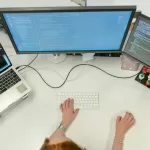One is using hybrid learning models more and more. Children have more possibilities since they can learn either online or personally. This special method of training basically changes the character of education by combining the finest features of online and in-person learning. Since technology keeps developing, hybrid learning is beginning to be a reasonable choice that would help teachers as well as pupils.
“Hybrid learning models” have genuine meaning as well.
Traditional face-to-face classroom environments are applied in mixed with digital media accessible online blended and hybrid learning models. Under this strategy, students can experience the best of both worlds. While online learning gives more independence, studying is more fun and active when one attends classes and interacts with others.
Students that only show up for class part-time and complete additional work online usually use this type of learning. Students find this arrangement perfect since it combines the best features of online and in-person learning. It also applies to folks with different learning styles.
Why would one want to use hybrid learning strategies?
The ability of blended learning approaches to be changed is one of its strongest points. Learning both at home and in a classroom allows pupils to get better in time management. This independence is especially important for non-traditional students juggling several responsibilities—such as those of working adults or those looking after their families.
Moreover, for more people hybrid learning models streamline schooling. Some students miss class for various purposes or related to their life circumstances. Still, online classes can provide knowledge to pupils. This enables more students from all walks of life to get the education they need independent of their residence or situation.
Moreover, hybrid learning can help other people in various different ways. While some kids excel in a typical classroom where they could personally connect with teachers and other students, others do better when they are let to work on their own. Combining two of these approaches allows hybrid models to give each student a tailored learning environment fit for their needs.
Using combined learning strategies
If mixed learning models are to be successful, they must be meticulously designed with technological components included. They have to pick the right websites and tools to go along with their specifically instructed approaches. Learning management systems (LMS), live chat systems, and digital resources accessible to help education could all be part of this.
Developing a logical program that suits both online and in-person components is quite crucial. They should ensure that the internet resources complement their intended classroom imparting value. This link guarantees that the process of learning stays simple and steady.
Teachers and children need also training and support. Online professors must also be proficient in using technology to run their courses; online students need to know how to make use of the internet to schedule their courses. Everyone needing help or training for the diverse learning environment can have it taken care of.
Hybrid learning models have flaws.
Though in many respects they are wonderful, mixed learning models have several negative aspects. One worries a lot about maybe technology going down. Learning online calls both a robust internet connection and useful digital tools. Lack of these tools could make it challenging for students to appropriately value the mixed model.
Ensuring people’s attention and desire offers still another difficulty. Some people discover that their involvement in the online parts of hybrid learning systems is less than in a regular classroom. Students have to be enthralled with and captivated by their learning. One way to achieve this is by chatting to and playing games with them online.
Using hybrid learning might make giving students grades on their work challenging at times. Teachers have to weigh fair approaches of assessing classroom and internet generated output. One can have a full picture of what students have acquired by means of a range of evaluation tools and well specified review criteria.
Given hybrid learning models, what comes next?
Mixed learning models look to be here for a long run considering the ongoing progress of technology. Including augmented reality (AR) and virtual reality (VR) to hybrid learning could let students have even more an exciting and hands-on approach to study.
Mixed learning approaches integrating fresh tools and resources will become more challenging as school technology develops. Better versions of these models could entirely change our learning process by offering even more choice, flexibility, and comfort.
Thanks to hybrid learning models, which mix the best aspects of face-to-face and online learning—the way education is delivered is essentially changing. These strategies have a chance to influence the direction of education since they allow flexibility, accessibility, and many ways of learning, so guiding the course of knowledge. More and more life-changing learning possibilities will be available as educators, schools, and students continue using mixed learning methodologies adopt.









